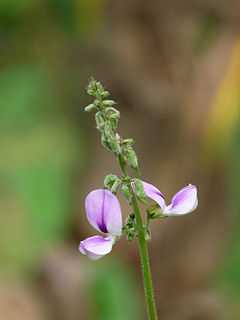Pueraria
| Pueraria | |
|---|---|
 | |
| Pueraria phaseoloides | |
| Scientific classification | |
| Kingdom: | Plantae |
| (unranked): | Angiosperms |
| (unranked): | Eudicots |
| (unranked): | Rosids |
| Order: | Fabales |
| Family: | Fabaceae |
| Subfamily: | Faboideae |
| Tribe: | Phaseoleae |
| Subtribe: | Glycininae |
| Genus: | Pueraria DC. |
| Species | |
|
About 15–20; see text | |
Pueraria is a genus of 15–20[1] species of plants native to Asia. Pueraria flower is used in traditional Chinese medicine to reduce reactions to alcohol consumption, and is undergoing scientific study for that use.[2] Pueraria thomsonii has been used in traditional Chinese medicine for treatment of fever, acute dysentery, diarrhea, diabetes, and cardiovascular diseases.[3]
The genus is polyphyletic, with different species being related to species in Glycine (which includes soybean), Amphicarpaea, Nogra, Teyleria, Neonotonia, Pseudovigna, Pseudeminia, Pachyrhizus (which includes jicama), and other genera of the tribe Phaseoleae.[4]
Species
These five species are closely related, and the name kudzu describes one or more of them. The morphological differences between the five species are subtle, they can breed with each other, and it appears that introduced kudzu populations in the United States have ancestry from more than one of the species.[5][6]
- P. edulis Pamp.[7]
- P. lobata (Willd.) Ohwi[7] (kudzu) (by some treated as P. montana var. lobata)[8]
- P. montana (Lour.) Merr.[7]
- P. phaseoloides (Roxb.) Benth.[7][9]
- P. thomsonii Benth.,[7] a synonym of P. montana var. chinensis[10]
Other plants that belong to this genus include:
- P. bella
- P. mirifica
- P. omeiensis Wang et Tang[7]
- P. peduncularis Grah.[7]
- P. tuberosa (Roxb.ex Willd.) DC.[1]
- P. wallichii (probably does not belong in Pueraria[4])
References
- ↑ 1.0 1.1 "Pueraria DC.". Flora of Pakistan.
- ↑ "Got a drinking problem? Try kudzu". MSNBC. Associated Press. 2006. Retrieved 2007-08-20.
- ↑ Wang L, Waltenberger B, Pferschy-Wenzig EM, Blunder M, Liu X, Malainer C, Blazevic T, Schwaiger S, Rollinger JM, Heiss EH, Schuster D, Kopp B, Bauer R, Stuppner H, Dirsch VM, Atanasov AG. Natural product agonists of peroxisome proliferator-activated receptor gamma (PPARγ): a review. Biochem Pharmacol. 2014 Jul 29. pii: S0006-2952(14)00424-9. doi: 10.1016/j.bcp.2014.07.018. PubMed PMID 25083916.
- ↑ 4.0 4.1 Lee, J; Hymowitz, T. (2001). "A Molecular Phylogenetic Study of the Subtribe Glycininae (Leguminosae) Derived from the Chloroplast DNA RPS16 Intron Sequences". American Journal of Botany (Botanical Society of America) 88 (11): 2064–2073. doi:10.2307/3558432. JSTOR 3558432.
- ↑ Jewett, D. K.; Jiang, C. J.; Britton, K. O.; Sun, J. H.; Tang, J. (2003). "Characterizing Specimens of Kudzu and Related Taxa with RAPD's". Castanea (Southern Appalachian Botanical Society) 68 (3): 254–260. ISSN 0008-7475. JSTOR 4034173.
- ↑ Sun, J. H.; Li, Z.-C.; Jewett, D. K.; Britton, K. O.; Ye, W. H.; Ge, X.-J. (2005). "Genetic Diversity of Pueraria lobata (Kudzu) and Closely Related Taxa as Revealed by Inter-Simple Sequence Repeat Analysis". Weed Research 45 (4): 255–260. doi:10.1111/j.1365-3180.2005.00462.x.
- ↑ 7.0 7.1 7.2 7.3 7.4 7.5 7.6 "Pueraria". Chinese Plant Names.
- ↑ "Pueraria montana var. lobata". Integrated Taxonomic Information System.
- ↑ "Pueraria DC.". Taiwan Plant Names.
- ↑ "The Plant List: A Working List of All Plant Species".
| Wikimedia Commons has media related to Pueraria. |